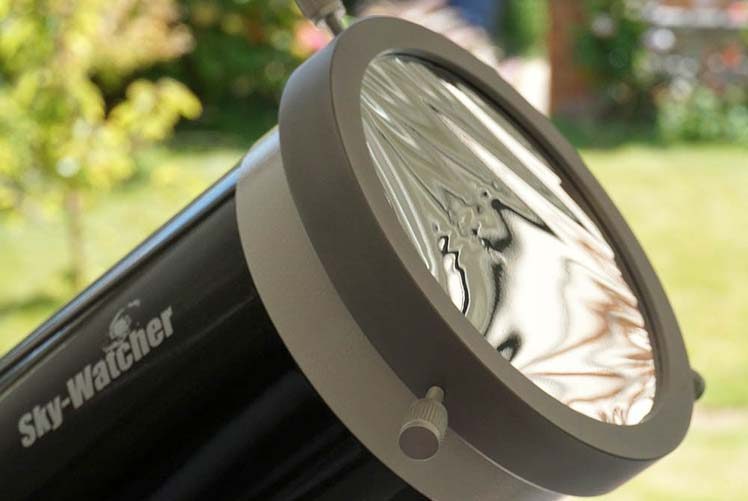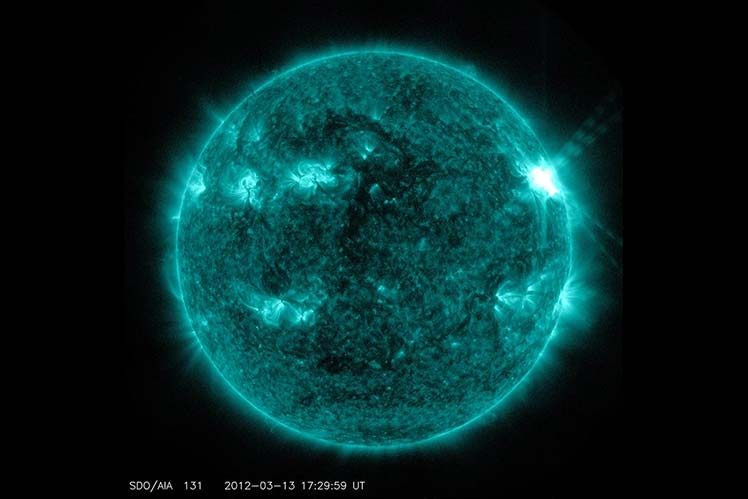On average, the Sun is only 150 million kilometres distant – hardly a stone’s throw away in astronomical terms, and being so close, it is an easy object to observe in great detail.
However, observing the Sun can be dangerous, and very specific precautions are required to prevent destroying your eyesight, and causing damage to observing equipment.
Here is how to observe the Sun safely.
Filter out 99% of the Sun’s light
Light from the Sun as shown in the image above contains almost the entire light spectrum, which contains many light frequencies that are not visible to human vision.
Two frequencies, infrared and ultraviolet, are particularly harmful and all of these frequencies must be filtered out to make solar viewing safe.
However, despite what you may have read or heard, materials like CD’s, smoked glass, several layers of photographic film, and many others are NOT able to filter out harmful light frequencies.
The only acceptable filter materials are materials such as aluminium-coated glass and Mylar film that are made to fit over the tubes or objective lenses of ordinary telescopes.
The image below shows a typical solar filter designed to fit securely over the tube of a reflecting telescope.

Filters like this block out at least 99% of the Sun’s light, including all infrared light that causes optical elements to heat up, and ultraviolet light that can permanently damage the human eye’s retina.
Nonetheless, even with the harmful light filtered out, the Sun is still too bright to make out any detail, which is why solar filters suitable for use by amateur observers are designed to allow only light in the Hydrogen Alpha or Calcium frequencies through, which is the frequencies of light emitted by most of the Sun’s visible features.
Of course, there are filters available for scientific observations, but these fall outside the scope of this article.
Nonetheless, solar filters should only ever be sourced from reputable dealers that stock and supply purpose-made solar filters that are designed not to fall off, or become dislodged from a telescope or pair of binoculars, which when it happens, can blind an observer in a very small fraction of a second.
Avoid filtered eyepieces
Although no reputable dealer in optical equipment will ever supply a filtered eyepiece today, there was time when this type of eyepiece was widely available.
This type of eyepiece incorporated a “solar filter” as a part of the optical elements of the eyepiece, but the unfortunate effect of this arrangement was that since eyepieces are essentially magnifying glasses, the heat build-up in the eyepiece could, (and often did), cause the eyepiece to explode, causing instant blindness.
Use a dedicated solar telescope
The telescope shown above is dedicated refracting solar telescope that blocks out somewhat more than 99% of the Sun’s light by using proprietary coatings on the lenses.
Note that although this particular example has an aperture of only 40 mm, it gathers sufficient light to provide crystal-clear images of solar features such as prominences and filaments.
Telescopes of this type allow only light emitted by hydrogen atoms through, which just happens to be the most active atoms on, or in the Sun.
Also, note that while some solar features can be seen by projecting the Sun’s light through a pinhole, features like prominences and filaments of active solar material can only be seen in hydrogen-alpha light, which is what solar telescopes are designed to provide.
Here is what you can expect see with a solar telescope
There is always something dramatic happening on the Sun, and with some luck, you may just see a violent coronal mass ejection on your first view of the Sun through a dedicated solar telescope.
Below are some images and details of what you can expect to see…
Solar prominences
Any solar prominence is always a dramatic event.

These vast clouds of dense solar material are usually visible just outside of the Sun’s photosphere, and they both created, and held captive by the Sun’s enormous arching magnetic fields that shift around due to the differential rotation between different parts of the Sun.
The best views of solar prominences can be had only with a proper solar telescope.
Sunspots
Sunspots are caused when the Sun’s magnetic field breaks in places, and “snaps” back through the solar “surface” as a result.
While sunspots may appear dark, or even black in telescopic views, they are in fact only visible because they are about 2000 or so degrees cooler than the surrounding area.
Sunspots only occur in an area about 45 degrees north and south of the solar equator, which is where the Sun’s differential rotation is the greatest.
Sunspots also always occur in pairs: one spot being the north pole of a snapped magnetic field, and the other being the south pole of the same field.
Sunspots can be seen equally well through dedicated solar telescopes and solar filters fitted to normal instruments.
Solar filaments
Solar filaments are smaller, less violent versions of solar prominences, and their most distinguishing feature is that they can be seen against the Sun’s disc, as shown in the image above.
Solar filaments are best viewed with a dedicated solar telescope.
Solar flares
Solar flares are among the most violent eruptions on the Sun, and they can extend millions of kilometres beyond the Sun’s surface.
Flares are caused by sudden changes in the arrangement of the Sun’s twisted magnetic fields, and although the actual mechanism is not yet clearly understood, one does not have to be solar scientist to be awed by the sudden ejection of billions of tons of solar material, which is best seen through a dedicated solar telescope.